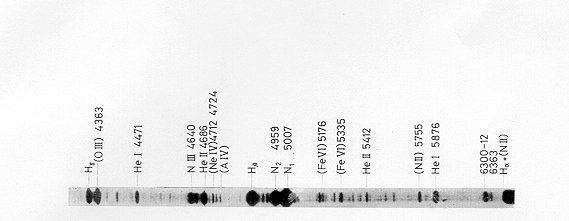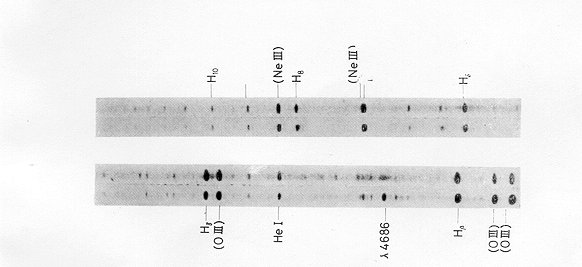Non-Periodic Phenomena in Variable Stars
IAU Colloquium, Budapest, 1968
SPECTRAL EVOLUTION OF THE PECULIAR STAR MHalpha 328-116
(V 1016 CYG) FROM 1965 TO 1967
A. MAMMANO, L. ROSINO
Astrophysical Observatory of Asiago, Italy
ABSTRACT
Some information are given on the spectral evolution of the peculiar
star MHalpha 328-116 from 1965 to the end of 1967. It is shown that the
degree of excitation is increasing. Some considerations on the nature of
the object follow.
A general study of the spectrum of MHalpha 328-116 in 1965 has been
published two years ago by the Authors (1966); a second detailed paper
on the spectrum 1966-67 is in print and will appear very soon (1968).
Only short informations on the spectral evolution of this interesting
object will therefore be given here.
The star was known as a faint emission object (m_pg = 15.5) since 1950,
when Merrill and Burwell (1950) included it in a list of 519 objects
with a bright Halpha. The spectrum was estimated near type M. The general
attention on this star was called, however, only in 1965 after the
announcement of McCuskey (1965) that the star had risen to magnitude 12
developing at the same time a very rich emission spectrum. Since then,
the variable has slowly increased in luminosity of about one magnitude
in two years.
The 1965 spectrum of MHalpha 328-116, as observed at Asiago on a
series of 16 spectrograms with dispersions between 40 and 180 A/mm at
H_gamma, was characterized by the presence of relatively sharp emission
lines of H (Balmer series from Halpha to H_18 and some infrared
components of the Paschen series), FeII, NIII, CIII, CIV and forbidden
lines of [NII], [OI], [OII], [OIII], [FeII], [FeIII], [SII], [SIII],
[NeIII], [AIII], etc. The N_1-N_2 nebular lines and the 4363 line of
[OIII] were particularly strong. The mean radial velocity was found to
be -65 +- 3 km/s. The spectrum maintained more or less the same
characteristics during the first months of 1966, but in November 1966 a
decisive increase of the degree of ionization was apparent. The
excitation further increased in 1967. Twenty five spectrograms were
obtained at Asiago with the 122 cm telescope during this period, some of
them, as that reproduced in Fig. 1, with the Carnegie intensifier
applied to camera VI of the cassegrain spectrograph (60 A/mm at H_gamma).
The spectral evolution in 1966-67 was chiefly characterized by a gradual
increase in the state of ionization, demonstrated by the strengthening
of the HeI and HeII lines, particularly HeII 4686, and by the emergence
of new lines of high ionization as OIII, [NeIV], [NeV], [AIV], [AV],
[FeV], [FeVI] which were not recorded or were faintly visible in the
spectra of 1965*. The new high ionization lines observed in 1967 are
reported in Table I.
* Boyarchuk (1968) claims that the excitation in MHalpha 328-116 was
decreasing in 1966 (October) as compared with 1965. The Asiago spectrograms
obtained in 1966 do not support his conclusions. It is true, however, that a
definite increase of excitation was only observed in the second half of November.
Another striking point has been the fading of the FeII permitted lines,
which disappeared or became very weak in 1967, while the forbidden lines
of [FeII] maintained their intensities or even strengthened. The fading
of the FeII permitted lines relative to the forbidden ones was also
observed by Thackeray (1955) in RR Tel.
Table I
New high ionization lines observed in the spectrum 1967 of MHalpha 328-116.
3426 [NeV] 1F 3924 HeII, [FeV] 4.3F 5060 [FeIII] 1F
3444 OIII 15 4181 [FeV] 1F 5146 [FeVI] 2F
3715 OIII 14 4230 [FeV] 1F 5176 [FeVI] 2F
3735 [FeV] 3F 4330 NIII 10 5192 [AIII] 3F
3757 OIII 2 4511 NIII 3 5237 [FeVI] 1F
3760 OIII 2 4626 [AV] 2F 5271 [FeIII] 1F
3774 OIII 2 4634 NIII 2 5309 [CaV] 1F
3790 OIII 2 4711 [AIV] 1F 5677 [FeVI] 1F
3813 HeII 4 4724 [NeIV] 1F 6087 [CaV] 1F
3820 [FeV] 3F 4740 [AIV] 1F 6102 [KIV] 1F
3839 [FeV] 3F 4754 [FeIII] 3F 6435 [AV] 1F
3892 [FeV] 3F 4769 [FeIII] 3F 7006 [AV] 1F
3896 [FeV] 1F 4778 [FeIII] 3F
3911 [FeV] 1F 4972 [FeVI] 2F
Fig. 2 illustrates the most conspicuous changes observed in the spectrum
1967 of MHalpha 328-116 when compared with the spectra obtained in
1965. The simultaneous presence in the spectra of lines emitted by atoms
in very different stages of ionization suggests stratification of the
emitting ions in an extended envelope, excited by a hot central star.
The increasing degree of excitation can be attributed partly to the
increasing temperature of the exciting source and partly to the
decreasing density of the envelope in slow expansion.
There still remain many uncertainties on the real physical nature of
MHalpha 328-116. There are three possibilities: a) that the star is a
symbiotic object, as suggested by the writers in 1966, and also by
McCuskey et al. (1966) and by Boyarchuk (1968). Although the light
curve is not typical of a symbiotic, this hypothesis remains the most
sound. b) That MHalpha 328-116 is a slow nova, like RR Tel. However,
the late pre-outburst spectral type, the absence of an absorption
spectrum near maximum and the appearance of a nebular spectrum while the
star is still increasing in brightness, are in disagreement with this
hypothesis. c) Finally, a third possibility is that the object may
represent an initial stage in the formation of a planetary nebula.
Further observations in the next years will probably give the
possibility of making a choice between the various hypotheses.
 Fig. 1. The spectrum of MHalpha 328-116. Carnegie Intensifier, Oct. 23, 1967.
Fig. 1. The spectrum of MHalpha 328-116. Carnegie Intensifier, Oct. 23, 1967.
 Fig. 2. Comparison of spectrum No. 6524 (August 8, 1965) with spectrum No. 7440
(Apr. 4, 1967) below. See the strengthening of HeII 4686.
REFERENCES
Boyarchuk, A. A., 1968, Astrophysica, 4, 289.
Fitzgerald, M. P., Houk, N. McCuskey, S. 1966, 1966, Astrophys. J. 144, 1135.
McCuskey, S. W., 1965, Circ. IAU 1916, 1917.
Mammano, A., Rosino, L., 1966, Mem. Soc. astr. ital. XXXVII, 493.
Mammano, A., Rosino, L., 1968, Mem. Soc. astr. ital., XXXIX, 471.
Merrill, P. W. and Burwell, C. G. 1950, Astrophys. J. 112, 72.
Thackeray, A. D. 1955, Mon. Not. R. astr. Soc. 115, 236.
COMMENT
Fernie: You may be interested to know that we have made some photoelectric
observations of this object at Toronto during the summer of 1968.
During this time it remained quiescent at about V = 11.06, with
fluctuations of no more than about +- 0.03 mag.
Fig. 2. Comparison of spectrum No. 6524 (August 8, 1965) with spectrum No. 7440
(Apr. 4, 1967) below. See the strengthening of HeII 4686.
REFERENCES
Boyarchuk, A. A., 1968, Astrophysica, 4, 289.
Fitzgerald, M. P., Houk, N. McCuskey, S. 1966, 1966, Astrophys. J. 144, 1135.
McCuskey, S. W., 1965, Circ. IAU 1916, 1917.
Mammano, A., Rosino, L., 1966, Mem. Soc. astr. ital. XXXVII, 493.
Mammano, A., Rosino, L., 1968, Mem. Soc. astr. ital., XXXIX, 471.
Merrill, P. W. and Burwell, C. G. 1950, Astrophys. J. 112, 72.
Thackeray, A. D. 1955, Mon. Not. R. astr. Soc. 115, 236.
COMMENT
Fernie: You may be interested to know that we have made some photoelectric
observations of this object at Toronto during the summer of 1968.
During this time it remained quiescent at about V = 11.06, with
fluctuations of no more than about +- 0.03 mag.
 Fig. 1. The spectrum of MHalpha 328-116. Carnegie Intensifier, Oct. 23, 1967.
Fig. 1. The spectrum of MHalpha 328-116. Carnegie Intensifier, Oct. 23, 1967.
 Fig. 2. Comparison of spectrum No. 6524 (August 8, 1965) with spectrum No. 7440
(Apr. 4, 1967) below. See the strengthening of HeII 4686.
REFERENCES
Boyarchuk, A. A., 1968, Astrophysica, 4, 289.
Fitzgerald, M. P., Houk, N. McCuskey, S. 1966, 1966, Astrophys. J. 144, 1135.
McCuskey, S. W., 1965, Circ. IAU 1916, 1917.
Mammano, A., Rosino, L., 1966, Mem. Soc. astr. ital. XXXVII, 493.
Mammano, A., Rosino, L., 1968, Mem. Soc. astr. ital., XXXIX, 471.
Merrill, P. W. and Burwell, C. G. 1950, Astrophys. J. 112, 72.
Thackeray, A. D. 1955, Mon. Not. R. astr. Soc. 115, 236.
COMMENT
Fernie: You may be interested to know that we have made some photoelectric
observations of this object at Toronto during the summer of 1968.
During this time it remained quiescent at about V = 11.06, with
fluctuations of no more than about +- 0.03 mag.
Fig. 2. Comparison of spectrum No. 6524 (August 8, 1965) with spectrum No. 7440
(Apr. 4, 1967) below. See the strengthening of HeII 4686.
REFERENCES
Boyarchuk, A. A., 1968, Astrophysica, 4, 289.
Fitzgerald, M. P., Houk, N. McCuskey, S. 1966, 1966, Astrophys. J. 144, 1135.
McCuskey, S. W., 1965, Circ. IAU 1916, 1917.
Mammano, A., Rosino, L., 1966, Mem. Soc. astr. ital. XXXVII, 493.
Mammano, A., Rosino, L., 1968, Mem. Soc. astr. ital., XXXIX, 471.
Merrill, P. W. and Burwell, C. G. 1950, Astrophys. J. 112, 72.
Thackeray, A. D. 1955, Mon. Not. R. astr. Soc. 115, 236.
COMMENT
Fernie: You may be interested to know that we have made some photoelectric
observations of this object at Toronto during the summer of 1968.
During this time it remained quiescent at about V = 11.06, with
fluctuations of no more than about +- 0.03 mag.